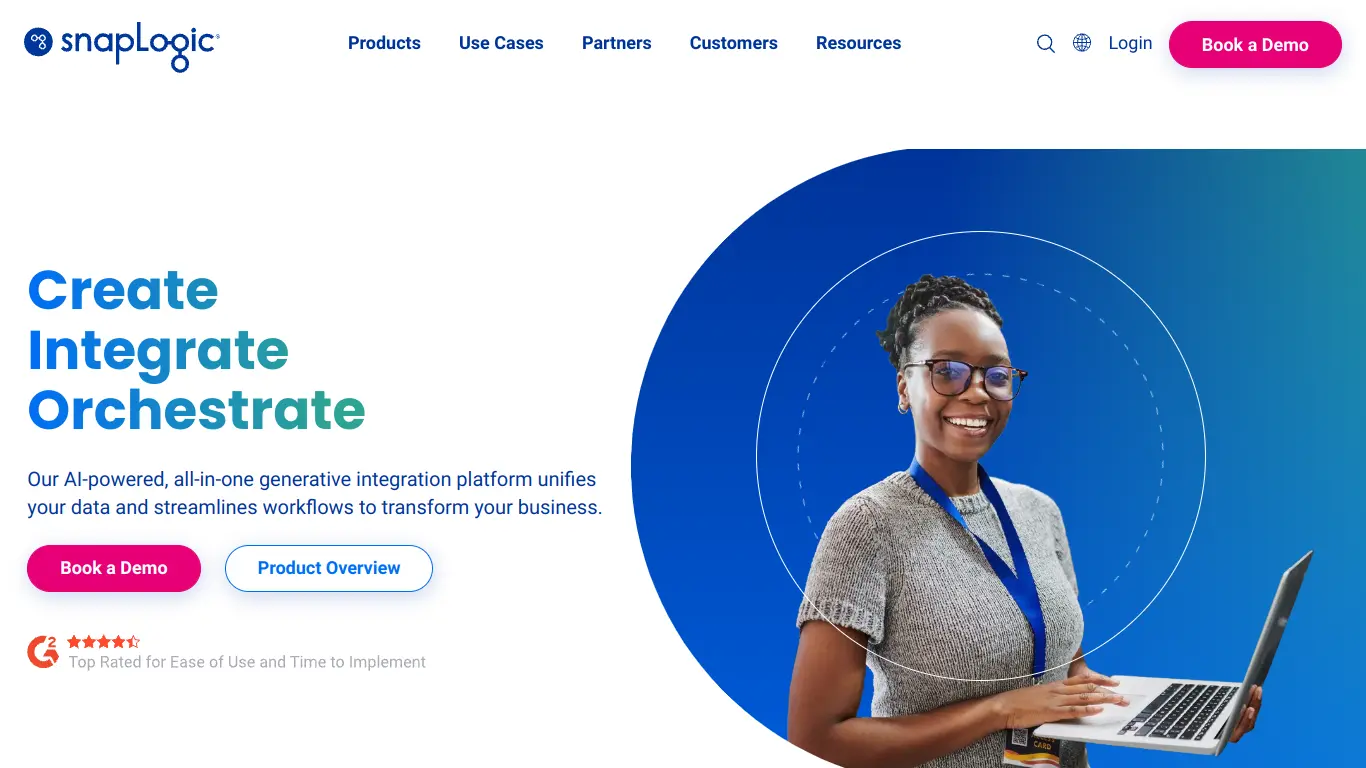SnapLogic is an enterprise iPaaS offering visual, AI-powered integration of applications, data, and processes for faster digital transformation.
Introduction to SnapLogic
You’ve likely experienced the frustration of data silos, manual workflows, and the complexity of connecting disparate systems. If you’re searching for a solution to these integration challenges, you’ve come to the right place. SnapLogic offers a powerful platform designed to streamline these processes and help organizations achieve true digital transformation.
What is SnapLogic and its Purpose?
SnapLogic is an intelligent integration platform as a service (iPaaS) that enables organizations to connect applications, data, and devices quickly and efficiently. Founded in 2006, SnapLogic has evolved from a basic integration tool into a comprehensive enterprise integration platform powered by artificial intelligence.
The platform’s core purpose is to eliminate the complexity of integration projects by providing a unified, cloud-based environment where users can create automated workflows (called pipelines) between various systems without extensive coding knowledge. SnapLogic accomplishes this through its innovative “Snap” technology—pre-built connectors that simplify the integration process.
SnapLogic’s mission is to help enterprises become data-driven by making it easier to move, manage, and analyze data across the organization. The platform serves as the connective tissue between on-premises systems, cloud applications, data warehouses, big data platforms, and IoT devices.
Who is SnapLogic Designed For?
SnapLogic caters to a diverse range of users across the enterprise spectrum:
- IT Professionals: Technical teams responsible for maintaining system integrations and data flows benefit from SnapLogic’s robust capabilities while reducing manual coding requirements.
- Data Engineers and Analysts: Those who need to move and transform data for analytics purposes appreciate the platform’s data integration capabilities.
- Business Analysts: Less technical users can leverage SnapLogic’s intuitive interface to create basic integrations without IT dependency.
- Enterprise Architects: Professionals designing the overall technology landscape value SnapLogic’s ability to connect legacy systems with modern cloud applications.
SnapLogic is particularly well-suited for medium to large enterprises with complex integration needs across multiple departments. Organizations undergoing digital transformation, cloud migration, or implementing data lake/warehouse projects find significant value in SnapLogic’s capabilities.
Industries that commonly utilize SnapLogic include:
- Healthcare
- Financial services
- Manufacturing
- Retail
- Technology
- Education
Getting Started with SnapLogic: How to Use It
Getting started with SnapLogic involves a straightforward process:
- Sign Up for an Account: Visit the SnapLogic website and request a demo or free trial.
- Access the SnapLogic Designer: After account creation, log in to the cloud-based designer interface—the primary environment for creating integrations.
- Learn the Basics:
- Snaps: These are the pre-built connectors for specific applications or functions
- Pipelines: Workflows that connect different systems and define data movement
- Projects: Organizational units that group related pipelines
- Tasks: Scheduled executions of pipelines
- Create Your First Pipeline:
- Drag and drop Snaps from the library onto the canvas
- Configure each Snap with the necessary connection details
- Link Snaps together to establish data flow
- Test and validate your pipeline
- Schedule or activate the pipeline for execution
- Utilize Learning Resources: SnapLogic provides extensive documentation, video tutorials, and a knowledge base to help new users learn the platform.
The learning curve for SnapLogic depends on your technical background. Users with integration experience can become productive within days, while those new to integration concepts might require a few weeks to become comfortable with the platform.
SnapLogic’s Key Features and Benefits
Core Functionalities of SnapLogic
SnapLogic offers a comprehensive set of features that address various integration challenges:
- Snap Technology: The platform provides 600+ pre-built intelligent connectors (Snaps) for popular applications, databases, APIs, and protocols, including Salesforce, Workday, SAP, Oracle, and many others.
- Integration Platform as a Service (iPaaS): Cloud-based architecture enables users to build, manage, and monitor integrations from anywhere with internet access.
- Visual Pipeline Designer: Intuitive drag-and-drop interface allows users to create integration workflows without extensive coding knowledge.
- Iris AI Technology: SnapLogic’s artificial intelligence engine provides intelligent suggestions, automated documentation, and predictive assistance during integration development.
- Enterprise Integration Patterns: The platform supports various integration patterns including data sync, API management, event-driven architecture, and ETL/ELT processes.
- Real-time and Batch Processing: Supports both real-time data flows and scheduled batch integrations to accommodate different business requirements.
- Data Transformation: Built-in tools for mapping, converting, and enriching data as it moves between systems.
- API Management: Ability to create, publish, and manage APIs without additional tools.
- Monitoring and Management: Comprehensive dashboards and alerts to track integration performance and address issues proactively.
- Scalable Execution: The Snaplex execution framework allows for distributed processing across multiple environments.
Advantages of Using SnapLogic
Using SnapLogic provides several significant benefits for organizations:
- Accelerated Integration Development: The visual interface and pre-built connectors reduce integration development time by up to 80% compared to traditional coding methods.
- Reduced Technical Debt: By standardizing on a single platform for various integration needs, companies can eliminate fragmented, hard-to-maintain custom code.
- Business and IT Collaboration: The intuitive interface enables business analysts to participate in the integration process, reducing IT bottlenecks.
- Future-proof Architecture: Cloud-native design ensures the platform can adapt to evolving technology landscapes and business requirements.
- Lower Total Cost of Ownership: Decreased development time, maintenance costs, and resource requirements translate to significant cost savings.
- Self-service Integration: Empowers more users to create and manage their own data pipelines without deep technical expertise.
- Enterprise Security: Robust security features including role-based access control, encryption, and compliance with industry standards.
- Flexibility and Adaptability: Works across cloud, hybrid, and on-premises environments to support diverse IT infrastructures.
- Rapid Time to Value: Organizations can implement solutions quickly and iterate as business needs evolve.
Main Use Cases and Applications
SnapLogic addresses numerous integration scenarios across the enterprise:
| Use Case | Description | Key Benefits |
|---|---|---|
| Application Integration | Connect SaaS, cloud, and on-premises applications to automate business processes | Eliminate manual data entry, improve data accuracy, enhance efficiency |
| Data Integration | Move, transform, and synchronize data between databases, data warehouses, and analytics platforms | Enable data-driven decision making, create unified data views |
| API Management | Design, publish, and manage APIs to expose business capabilities to partners and customers | New revenue streams, improved partner integration, enhanced customer experiences |
| Cloud Data Warehousing | Load and transform data for cloud data warehouses like Snowflake, Amazon Redshift, and Google BigQuery | Accelerate analytics initiatives, improve data accessibility |
| Big Data Integration | Connect to Hadoop, Spark, and other big data technologies | Unlock insights from large data volumes, enable advanced analytics |
| B2B Integration | Facilitate secure data exchange with external partners and suppliers | Streamline supply chain, improve partner relationships |
| Legacy Modernization | Connect legacy systems to modern applications and cloud services | Extend the value of existing investments, gradual modernization approach |
| Internet of Things (IoT) | Process and analyze data from connected devices and sensors | Enable real-time monitoring, predictive maintenance capabilities |
Real-world examples include:
- A healthcare provider using SnapLogic to integrate patient records across multiple systems
- A financial services firm automating regulatory reporting by connecting data sources
- A manufacturer streamlining supply chain by connecting ERP, CRM, and supplier systems
Exploring SnapLogic’s Platform and Interface
User Interface and User Experience
SnapLogic’s user interface is designed to accommodate users with varying technical backgrounds while providing powerful functionality for complex integration scenarios.
The main components of the interface include:
- SnapLogic Designer: The central web-based environment where users build integration pipelines. Key elements include:
- Snap Palette: A searchable library of all available connectors and processing tools
- Canvas: The workspace where pipelines are visually constructed
- Properties Panel: Configuration area for individual Snaps and pipeline parameters
- Dashboard: Overview of recent projects, pipelines, and execution status
- Manager: Administrative interface for managing users, permissions, connections, and monitoring system health.
- Monitoring Dashboard: Real-time view of pipeline executions, errors, and performance metrics.
The interface follows modern design principles with intuitive navigation, consistent layouts, and contextual help. Color coding helps users quickly identify Snap types and execution status, while thoughtful organization of tools and properties minimizes clicks required for common tasks.
The visual approach to pipeline building makes complex integration concepts more accessible. Users can see the data flow from source to target, with transformation steps clearly visualized in between. Error handling is also integrated visually, making it easier to create robust pipelines.
SnapLogic’s user experience has evolved significantly over the years based on customer feedback. The platform strikes a balance between simplicity for basic tasks and depth for advanced scenarios, although some users report that the learning curve can be steeper for complex transformations.
Platform Accessibility
SnapLogic is designed for accessibility across various environments and user contexts:
- Browser-Based Access: The primary interface is entirely web-based, requiring no software installation for designers and allowing access from any location with internet connectivity.
- Mobile Responsiveness: The management interface adapts to mobile devices, enabling administrators to monitor integrations on the go, though pipeline development is optimized for desktop use.
- Cross-Browser Compatibility: SnapLogic supports all major modern browsers including Chrome, Firefox, Safari, and Edge.
- REST API Access: All platform functionality is accessible via REST APIs, allowing programmatic control and integration with DevOps tools.
- Deployment Flexibility: The execution architecture (Snaplex) can be deployed across multiple environments:
- Cloud Snaplex: Hosted and managed by SnapLogic for simplified operations
- Groundplex: On-premises deployment for accessing systems behind firewalls
- Cloudplex: Customer-managed deployment in their own cloud infrastructure
- Integration with CI/CD: Support for continuous integration/continuous deployment workflows through API access and version control integration.
- Enterprise SSO: Integration with identity providers for streamlined authentication and enhanced security.
The platform is designed to meet enterprise accessibility requirements, though the full extent of WCAG compliance isn’t specifically detailed in public documentation.
SnapLogic Pricing and Plans
Subscription Options
SnapLogic follows an enterprise subscription model with pricing tailored to each organization’s needs. While specific pricing isn’t publicly available on their website, the company offers several subscription tiers based on common enterprise requirements:
- Standard Edition: Entry-level offering suitable for departments or smaller organizations with basic integration needs.
- Enterprise Edition: Comprehensive offering with full platform capabilities, designed for organization-wide deployment.
- Enterprise Plus: Enhanced edition with additional features for large enterprises with complex integration requirements.
Key factors that influence pricing include:
- Number of users (developers, administrators)
- Volume of data processed
- Number of connections required
- Execution capacity needs (pipeline concurrency)
- Support level requirements
- On-premises vs. cloud deployment mix
The subscription model is typically annual, though multi-year agreements are available with potential discounting. For precise pricing information, prospective customers must contact SnapLogic’s sales team for a customized quote based on their specific requirements.
Free vs. Paid Features
SnapLogic doesn’t offer a permanent free tier but provides several options for exploring the platform before purchase:
Free Trial: SnapLogic offers a time-limited trial that includes:
- Access to the core platform capabilities
- Limited set of pre-built connectors
- Ability to build and test basic pipelines
- Access to documentation and basic support
Free Resources:
- Extensive documentation and knowledge base
- Video tutorials and webinars
- Community forums
- White papers and best practices guides
Paid Features (available in full subscriptions):
- Complete library of 600+ pre-built Snaps
- Enterprise-grade security features
- High availability and disaster recovery
- Advanced monitoring and alerting
- Premium support with defined SLAs
- Iris AI capabilities
- Unlimited pipeline execution
- API management capabilities
- Multiple environment support
SnapLogic occasionally offers free workshops and training sessions to help potential customers evaluate the platform. The company also provides sandbox environments for proof-of-concept projects to demonstrate value before full commitment.
For organizations seriously considering SnapLogic, requesting a customized demonstration focused on your specific use cases is recommended to assess the platform’s suitability for your requirements.
SnapLogic Reviews and User Feedback
Pros and Cons of SnapLogic
Based on user reviews and feedback across multiple platforms including G2, Gartner Peer Insights, and TrustRadius, here’s a balanced assessment of SnapLogic’s strengths and limitations:
Pros:
- Intuitive Visual Interface: Users consistently praise the drag-and-drop interface, which makes integration accessible to broader team members.
- Extensive Connector Library: The wide range of pre-built Snaps for popular systems significantly reduces development time.
- Flexibility: The platform handles various integration patterns from simple data sync to complex event-driven architectures.
- Cloud-Native Architecture: The cloud-based approach offers scalability and accessibility advantages.
- Rapid Implementation: Many users report quick time-to-value compared to traditional integration approaches.
- Strong Support: Customer support receives high marks for responsiveness and expertise.
- Regular Updates: Consistent platform enhancements and new connectors show ongoing product investment.
- Enterprise-Grade Security: Robust security features meet the requirements of regulated industries.
Cons:
- Learning Curve: Despite the visual interface, some users report a steeper learning curve for advanced features.
- Pricing: Several reviews mention that pricing can be higher than some competitors, particularly for smaller organizations.
- Performance with Large Datasets: Some users report performance challenges when processing very large data volumes.
- Documentation Gaps: While documentation is extensive, some users note that certain advanced scenarios lack detailed guidance.
- Customization Complexity: Creating custom Snaps or complex transformations can require deeper technical skills.
- Error Handling: A few reviews mention that error messages could be more intuitive for troubleshooting.
- Mobile Experience: The mobile interface is primarily for monitoring rather than development.
- Version Control: Some users wish for more robust version control and change management features.
User Testimonials and Opinions
Here are selected user testimonials representing diverse perspectives on SnapLogic:
“SnapLogic has transformed how we approach integration projects. What used to take weeks of coding now takes days of visual pipeline building. The ROI has been tremendous, not just in development time but in maintenance as well.” – IT Director, Healthcare Organization
“We evaluated several iPaaS solutions and chose SnapLogic for its balance of power and usability. The learning curve was steeper than expected, but once our team got comfortable, we’ve been able to accelerate our digital transformation initiatives significantly.” – Enterprise Architect, Manufacturing Company
“As a data analyst with limited coding experience, SnapLogic has empowered me to create my own data pipelines without constantly requesting IT support. The visual interface is intuitive, though I sometimes hit limitations with complex transformations.” – Business Analyst, Retail Organization
“SnapLogic’s support team deserves special mention. When we encountered issues during implementation, their response was quick and thorough. They didn’t just solve the immediate problem but helped us optimize our approach.” – Integration Developer, Financial Services
“While we’re generally satisfied with SnapLogic, the pricing model became challenging as we scaled up. Be sure to plan your growth and negotiate accordingly.” – CIO, Technology Company
Industry analysts also provide generally positive assessments:
- Gartner has positioned SnapLogic as a Leader in the Magic Quadrant for Enterprise Integration Platform as a Service multiple times.
- Forrester recognizes SnapLogic’s strength in supporting hybrid integration scenarios.
The platform scores particularly well in categories like ease of use, quality of support, and breadth of connectors, while receiving more mixed feedback on pricing and advanced customization.
SnapLogic Company and Background Information
About the Company Behind SnapLogic
SnapLogic was founded in 2006 by Gaurav Dhillon, who previously co-founded and led Informatica, a pioneering data integration company. This heritage in data integration provided SnapLogic with deep industry expertise from its inception. The company is headquartered in San Mateo, California, with offices across North America, Europe, and Asia-Pacific.
Leadership Team:
- Gaurav Dhillon – CEO and Chairman
- Craig Stewart – Chief Technology Officer
- Dayle Hall – Chief Marketing Officer
- Jeremiah Stone – Chief Operating Officer
Company Growth and Funding:
SnapLogic has secured significant funding to fuel its growth, with over $200 million raised across multiple rounds. Notable investors include Andreessen Horowitz, Ignition Partners, Microsoft, and Salesforce Ventures. This financial backing has enabled the company to expand globally and continually enhance its platform.
Company Vision:
SnapLogic’s vision centers on enabling the “autonomous enterprise” where data flows freely across organizations, breaking down silos and enabling automation at scale. The company aims to make integration accessible to more users while handling increasingly complex scenarios.
Corporate Culture:
The company emphasizes innovation, customer success, and diversity. SnapLogic maintains a collaborative culture focused on solving complex integration challenges while making the technology accessible to broader audiences.
Market Position:
SnapLogic has established itself as a significant player in the integration platform as a service (iPaaS) market, particularly for enterprises with complex, multi-cloud environments. The company serves over 1,000 enterprise customers across various industries and processes billions of transactions daily.
Strategic Partnerships:
SnapLogic maintains strategic partnerships with major technology providers including AWS, Google Cloud, Microsoft Azure, Snowflake, and Workday, among others. These partnerships help extend the platform’s capabilities and provide optimized connectors for popular enterprise systems.
Corporate Social Responsibility:
The company demonstrates commitment to corporate responsibility through initiatives supporting education in technology fields and promoting diversity in the tech workforce.
As the integration market continues to evolve, SnapLogic has adapted its strategy to address emerging trends including AI/ML integration, API management, and data lake/warehouse automation. The company’s long-term vision focuses on making enterprise integration more autonomous through continued AI advancements.
SnapLogic Alternatives and Competitors
Top SnapLogic Alternatives in the Market
The integration platform space offers several alternatives to SnapLogic, each with distinct strengths. Here are the top alternatives worth considering:
- MuleSoft Anypoint Platform
- Owned by Salesforce, MuleSoft offers strong API management capabilities alongside integration functionality
- Particularly strong for organizations heavily invested in the Salesforce ecosystem
- Features a robust development environment with reusable components
- Informatica Intelligent Cloud Services (IICS)
- Comprehensive data integration platform with deep roots in data management
- Excels at complex data transformation and master data management
- Offers strong governance and compliance features
- Dell Boomi
- Pioneer in cloud-based integration with an intuitive interface
- Strong middleware capabilities with robust process automation
- Offers a large library of connectors and pre-built templates
- Jitterbit
- User-friendly platform focusing on ease of implementation
- Strong citizen integrator capabilities
- Competitive pricing for mid-market organizations
- Workato
- Emphasizes business process automation alongside integration
- Recipe-based approach aimed at business users
- Strong community and template marketplace
- Microsoft Azure Logic Apps
- Deeply integrated with Microsoft ecosystem
- Serverless approach with consumption-based pricing
- Strong for organizations already invested in Azure
- Talend
- Open-source roots with strong data quality capabilities
- Comprehensive data integration and management platform
- Offers both cloud and on-premises deployment options
- Zapier (for simpler use cases)
- Focuses on easy automation between web applications
- Template-based approach requires minimal technical knowledge
- More suitable for departmental or SMB use cases rather than enterprise-wide integration
SnapLogic vs. Competitors: A Comparative Analysis
When comparing SnapLogic to its competitors, several factors differentiate the platforms:
| Feature | SnapLogic | MuleSoft | Informatica IICS | Dell Boomi | Workato |
|---|---|---|---|---|---|
| Primary Strength | Visual pipeline designer with AI assistance | API-led approach with strong governance | Deep data management capabilities | Ease of use with broad connectivity | Business automation focus |
| Target Users | Both technical and business users | More developer-focused | Data integration specialists | Broad range from IT to business | Business process owners |
| Learning Curve | Moderate | Steeper | Moderate to steep | Moderate | Lower |
| Pricing Model | Subscription-based, enterprise focus | Subscription with API call limitations | Consumption-based pricing | User and connector-based pricing | Process and connector-based |
| Deployment Options | Cloud, hybrid, on-premises | Cloud, hybrid, on-premises | Cloud, hybrid | Cloud-focused with edge capabilities | Cloud-focused |
| AI Capabilities | Iris AI for suggestions and automation | Limited but evolving | Strong data intelligence | Growing capabilities | Automation recommendations |
| Integration Patterns | Broad support for multiple patterns | API-centric with other patterns | Data-centric integration | Process-focused integration | Automation-centric |
| Scalability | Highly scalable with distributed architecture | Very high scalability with microservices | Enterprise-grade scalability | Good scalability for most use cases | Growing enterprise capabilities |
Key Differentiation Points:
- SnapLogic stands out with its visual, AI-assisted development environment that balances accessibility with enterprise capabilities. Its Snap-based architecture makes it particularly adaptable to diverse integration scenarios.
- MuleSoft excels with its API-first approach and comprehensive API lifecycle management, making it ideal for organizations building API ecosystems.
- Informatica offers unmatched depth in data management, data quality, and governance, making it superior for complex data integration challenges.
- Boomi provides a well-rounded platform with a focus on ease of use and quick implementation, appealing to organizations seeking balance between capability and simplicity.
- Workato emphasizes business process automation alongside integration, making it particularly strong for line-of-business automation needs.
The right choice depends on specific organizational requirements:
- For visually-oriented teams seeking balance between power and usability: SnapLogic
- For API-centric architecture and developer ecosystems: MuleSoft
- For complex data management needs: Informatica
- For rapid implementation with minimal specialized skills: Boomi or Workato
- For Microsoft-centric organizations: Azure Logic Apps
Many enterprises employ multiple integration tools for different scenarios, with SnapLogic often serving as the central platform while specialized tools address specific requirements.
SnapLogic Website Traffic and Analytics
Website Visit Over Time
SnapLogic’s website (snaplogic.com) demonstrates traffic patterns typical of an enterprise B2B technology provider. While exact numbers fluctuate, analysis of available data shows several interesting trends:
📊 Traffic Trends:
- Steady Growth: The site has shown consistent year-over-year growth in traffic, reflecting increased market interest in integration platforms
- Seasonal Patterns: Traffic typically peaks during Q1 and Q4, corresponding with enterprise IT planning and budgeting cycles
- Event Spikes: Notable traffic increases coincide with product launches, industry conferences, and webinar events
- Content Impact: Blog posts and resource publications drive significant traffic peaks
The website averages hundreds of thousands of visits monthly, with particular interest in product documentation, customer stories, and technical resources. Traffic has increased substantially during the pandemic period as digital transformation initiatives accelerated.
Geographical Distribution of Users
SnapLogic’s website visitors reflect the company’s global market presence, with significant traffic from multiple regions:
🌎 Top Regions by Traffic:
- North America (United States, Canada) – Approximately 45-50% of traffic
- Europe (UK, Germany, France, Netherlands) – Approximately 25-30% of traffic
- Asia-Pacific (India, Australia, Singapore, Japan) – Approximately 15-20% of traffic
- Rest of World – Approximately 5-10% of traffic
The United States represents the largest single country for website traffic, followed by the United Kingdom and India. This distribution aligns with SnapLogic’s office locations and market focus.
Visitor engagement metrics vary by region, with North American visitors typically showing longer session durations and European visitors demonstrating higher conversion rates on resource downloads.
Main Traffic Sources
SnapLogic’s website traffic comes from diverse sources, reflecting a comprehensive digital marketing strategy:
🔍 Traffic Source Breakdown:
- Organic Search: Approximately 40-45% of traffic comes from search engines, with strong performance for integration-related keywords
- Direct Traffic: Approximately 20-25% from users directly accessing the site
- Referral Traffic: Approximately 15-20% from industry publications, partner websites, and technology review platforms
- Social Media: Approximately 8-10%, primarily from LinkedIn and Twitter
- Paid Search/Advertising: Approximately 8-12% from targeted advertising campaigns
- Email Marketing: Approximately 5-8% from newsletter and campaign communications
The most effective content for driving traffic includes:
- Technical blogs addressing specific integration challenges
- Customer success stories and case studies
- Integration trend analysis and market research
- Comparison guides and evaluation resources
- Educational webinars and event recordings
The company has seen increasing engagement with video content and interactive tools, reflecting changing B2B content consumption preferences.
These traffic patterns demonstrate SnapLogic’s established position in the enterprise integration market, with strong interest from technical decision-makers and integration specialists.
Frequently Asked Questions about SnapLogic (FAQs)
General Questions about SnapLogic
What is SnapLogic and how does it work?
SnapLogic is an Integration Platform as a Service (iPaaS) that connects applications, data sources, and devices through a visual, drag-and-drop interface. It works by using pre-built connectors called “Snaps” that you arrange into “pipelines” to automate data flows and business processes. The platform executes these pipelines in distributed environments called “Snaplexes,” which can run in the cloud or on-premises.
Is SnapLogic suitable for small businesses?
While SnapLogic can technically work for any size organization, its pricing model and feature set are primarily designed for mid-sized to large enterprises. Small businesses with simple integration needs might find more cost-effective solutions elsewhere, unless they have particularly complex integration requirements or are in a rapid growth phase.
How long does it take to implement SnapLogic?
Initial implementation can range from a few days to several weeks, depending on your organization’s complexity and requirements. Basic pipelines can be created in hours, while enterprise-wide deployment with multiple connections and complex data flows typically takes 4-12 weeks for full implementation. SnapLogic provides implementation services to accelerate this process.
Does SnapLogic require coding knowledge?
Basic integration scenarios require minimal coding thanks to the visual interface and pre-built Snaps. However, advanced transformations, custom Snap development, and complex integration patterns benefit from JavaScript, JSON, and SQL knowledge. Most organizations use a mix of low-code development for standard integrations and more technical approaches for specialized needs.
Feature Specific Questions
What types of systems can SnapLogic connect?
SnapLogic can connect virtually any system with its 600+ pre-built Snaps, including:
- SaaS applications (Salesforce, Workday, ServiceNow, etc.)
- Cloud platforms (AWS, Azure, Google Cloud)
- Databases (SQL, NoSQL, data warehouses)
- Big data systems (Hadoop, Spark)
- Social media platforms
- File systems and message queues
- Custom applications via REST/SOAP APIs
- Legacy systems and mainframes
- IoT devices and platforms
What is Iris AI and how does it enhance SnapLogic?
Iris AI is SnapLogic’s artificial intelligence technology that makes integration development more efficient. It provides:
- Automated suggestions for pipeline building based on patterns
- Predictive data mapping between sources and targets
- Natural language search capabilities for finding Snaps
- Anomaly detection and performance recommendations
- Self-documentation of integration processes
The technology learns from patterns across the SnapLogic user community while respecting privacy boundaries.
Can SnapLogic handle real-time integrations?
Yes, SnapLogic supports both batch and real-time integration patterns. Real-time capabilities include:
- Event-driven triggers
- Webhook support
- API-based integrations
- Streaming data processing
- Ultra pipelines for high-throughput scenarios
Response times for real-time integrations typically range from sub-second to a few seconds depending on complexity and configuration.
How does SnapLogic ensure data security?
SnapLogic employs multiple security measures:
- Encryption of data in transit and at rest
- Role-based access control (RBAC)
- Single sign-on (SSO) integration
- OAuth and API key support
- Audit logging of all activities
- Compliance with SOC 2, GDPR, HIPAA, and other standards
- Network isolation options
- Regular security assessments and penetration testing
Pricing and Subscription FAQs
How much does SnapLogic cost?
SnapLogic pricing is custom-quoted based on several factors:
- Number of users/developers
- Data volume processed
- Number of connections needed
- Deployment model (cloud vs. hybrid/on-premises)
- Support level requirements
Annual subscriptions typically start in the tens of thousands of dollars for enterprise implementations. For specific pricing, you’ll need to contact SnapLogic’s sales team for a customized quote.
Is there a free trial available for SnapLogic?
Yes, SnapLogic offers a time-limited trial that allows you to explore the platform’s capabilities. The trial includes access to a subset of Snaps and core platform features. You can request a trial through the SnapLogic website, though it may require a qualification call with sales to ensure the platform aligns with your needs.
What’s included in a typical SnapLogic subscription?
Standard subscriptions typically include:
- Access to the SnapLogic designer environment
- Core set of Snaps (connectors)
- Pipeline execution capabilities
- Basic monitoring and management tools
- Standard support
Premium subscriptions may add:
- Advanced Snaps for specialized systems
- Enhanced security features
- Higher throughput and performance
- Additional environments (dev, test, prod)
- Premium support with faster response times
- Implementation and training services
Can I customize my SnapLogic subscription?
Yes, SnapLogic works with customers to create tailored subscription packages. You can select specific Snap packs relevant to your integration needs, choose appropriate execution capacity, and select the level of support required. As your needs evolve, subscriptions can be adjusted accordingly.
Support and Help FAQs
What support options does SnapLogic provide?
SnapLogic offers tiered support options:
- Standard Support: Business hours assistance, access to knowledge base
- Premium Support: 24/7 support for critical issues, faster response times
- Platinum Support: Dedicated support contacts, proactive monitoring
Support is available through multiple channels including web portal, email, and phone. The company also provides a community forum for peer assistance.
How does SnapLogic handle product updates?
SnapLogic follows a regular release schedule with:
- Major releases (significant new features) quarterly
- Minor updates and bug fixes monthly
- Critical patches as needed
For cloud deployments, updates are applied automatically during maintenance windows. For on-premises components, customers control the update timing. SnapLogic provides detailed release notes and pre-release documentation to prepare for changes.
What training resources are available for SnapLogic users?
SnapLogic offers comprehensive training through:
- Self-paced online learning (SnapLogic University)
- Instructor-led virtual and in-person courses
- Certification programs for developers and administrators
- Documentation and video tutorials
- Regular webinars on features and best practices
- Professional services for customized training
Most customers utilize a combination of these resources to build internal expertise.
Conclusion: Is SnapLogic Worth It?
Summary of SnapLogic’s Strengths and Weaknesses
After a comprehensive review of SnapLogic’s capabilities, market position, and user feedback, here’s a balanced assessment of the platform’s key strengths and weaknesses:
Strengths:
- Visual, Intuitive Interface: The drag-and-drop pipeline designer makes integration accessible to a broader range of users, reducing dependency on specialized developers.
- Comprehensive Connector Library: With 600+ pre-built Snaps, the platform connects to virtually any enterprise system, reducing development time significantly.
- Flexible Deployment Options: The ability to run in cloud, hybrid, or on-premises environments accommodates diverse infrastructure requirements.
- AI-Enhanced Development: Iris AI provides intelligent suggestions and automation that accelerate integration development and reduce errors.
- Enterprise-Grade Capabilities: Robust security, scalability, and monitoring features satisfy the requirements of large enterprises and regulated industries.
- Unified Platform: A single solution addresses multiple integration patterns from data movement to API management to process automation.
- Strong Industry Recognition: Consistently recognized as a leader by analyst firms like Gartner and Forrester.
- Regular Innovation: Continuous platform enhancements demonstrate ongoing investment and commitment to evolution.
Weaknesses:
- Enterprise-Focused Pricing: The cost structure is more suitable for mid-to-large enterprises, potentially placing it out of reach for smaller organizations.
- Learning Curve for Advanced Features: While basic functionality is accessible, mastering advanced capabilities requires significant investment in learning.
- Performance Variability: Some users report performance challenges with very large data volumes or complex transformations.
- Documentation Gaps: While extensive, documentation sometimes lacks depth for more specialized scenarios.
- Customization Complexity: Creating custom Snaps or complex JavaScript transformations requires more technical expertise.
- Implementation Resources Required: Successful enterprise-wide adoption typically requires dedicated resources and planning.
Final Recommendation and Verdict
Is SnapLogic worth the investment? The answer depends on your organization’s specific needs, resources, and integration challenges.
SnapLogic represents an excellent choice for:
- Mid-sized to large enterprises with diverse integration requirements
- Organizations undergoing digital transformation or cloud migration initiatives
- Companies seeking to reduce technical debt from multiple point-to-point integrations
- Businesses that need both technical and business user participation in integration processes
- Organizations with hybrid IT environments spanning cloud and on-premises systems
- Teams looking to accelerate integration development with AI assistance
SnapLogic may not be the ideal fit for:
- Small businesses with limited integration needs and budget constraints
- Organizations seeking the absolute lowest-cost integration solution
- Teams with very specialized integration patterns not well-supported by pre-built connectors
- Companies without resources to invest in platform learning and optimization
Final Verdict: For enterprises serious about streamlining integration processes across their organization, SnapLogic delivers substantial value through its combination of accessibility, power, and flexibility. While the investment is significant both financially and in terms of learning curve, the platform’s ability to accelerate digital initiatives and reduce long-term integration costs creates compelling ROI for most enterprise customers.
Organizations should begin with a clearly defined proof-of-concept project focused on specific high-value integration challenges to evaluate the platform’s fit for their unique requirements before full-scale deployment. SnapLogic’s free trial and demo options provide a practical starting point for this evaluation process.
In today’s rapidly evolving digital landscape, the ability to connect systems quickly and reliably has become a critical competitive advantage. For organizations facing complex integration challenges, SnapLogic offers a powerful, future-focused platform that can significantly accelerate digital transformation efforts.




















